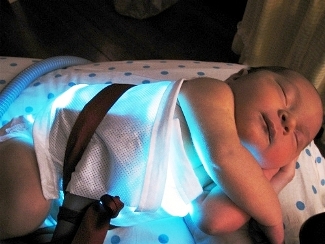Jaundice in infants, characterized by yellowish discoloration of eyes and skin, is a consequence of excess bilirubin in the blood– a break down product of red blood cells. It is a common occurrence in pre-term (babies born before 38 weeks of gestation) and breast-fed babies. While an underlying pathology may be the cause, jaundice in infants is mostly due to an immature liver that is unable to get rid of the excess bilirubin in blood. This article focuses on the treatments used to treat baby born jaundice, like phototherapy.
How Does Phototherapy for Jaundice Work?
The most common treatment option for reducing elevated bilirubin levels in a jaundiced newborn is phototherapy. Phototherapy involves the use of light to bring down the bilirubin levels to normal through a process called photo-oxidation. The process facilitates dissolution of bilirubin in water by adding oxygen to it, which makes it easy for the liver to break it down, remove it out of blood and eventually excrete it in stool and urine. There are two major types of phototherapy:
1. Conventional Phototherapy
In this type of phototherapy, baby is exposed to a specific type of fluorescent light for several days, which is absorbed into the skin but doesn't damage the skin. It involves:
- Undressing the baby for maximum exposure of skin to light
- Covering baby's eyes to protect the innermost nerve layer (retina)
- Continue breastfeeding in a normal and usual routine
- Regularly assess the bilirubin levels (at least once a day)
While there is no skin damage, there is a potential risk of:
- Skin rash
- Retinal damage due to improper covering of eyes
- Dehydration due to inadequate fluid input or feeding
- Inability to maintain proper body temperature
2. Fiberoptic Phototherapy
Another type of phototherapy for jaundice is fiberoptic therapy which  involves wrapping of a fiberoptic band or blanket around baby's body. Although the therapy offers the convenience of being used at home, it takes longer than the conventional type to bring the bilirubin levels down to normal. Therefore it is an option for babies with mild jaundice who are otherwise healthy.
involves wrapping of a fiberoptic band or blanket around baby's body. Although the therapy offers the convenience of being used at home, it takes longer than the conventional type to bring the bilirubin levels down to normal. Therefore it is an option for babies with mild jaundice who are otherwise healthy.
Understanding the mechanism and equipment is of immense importance here, so that the device works properly in the setting of home. Make sure you're well informed and guided about how to use the device before you start using it. Also, it is recommended to visit the doctor and get the bilirubin levels measured regularly.
Other Treatments for Jaundice in Newborns
Phototherapy for jaundice is undoubtedly a very common treatment option in jaundiced infants. However, in mild or severe cases of jaundice, your healthcare provider may suggest other options and remedies.
1. Change Feeding Patterns
A changed feeding routine or in simple words frequent feeding may help in getting rid of bilirubin faster by causing more bowel movements. In order to take care of mild jaundice, formula fed babies should be given 30-60ml of milk every 2-3 hours, and breastfed babies should have around 8-12 feeds per day for several days.
2. Exchange Transfusion
Besides phototherapy for jaundice and encouraging bowel movements, exchange transfusion is also effective in treating jaundice in babies. This is often advised by doctors for severely jaundiced babies with high levels of bilirubin or if phototherapy has fails to clear that excessive bilirubin.
As the name implies, this procedure first removes small amount of blood from a jaundiced baby via tubes inserted in blood vessels of baby's arms, legs or the umbilical cord; then the removed blood is replaced with blood from a suitable donor. Donor's blood having normal bilirubin replaces baby's high-bilirubin blood allowing the bilirubin levels to drop down to normal.
The transfusion takes several hours and the baby is constantly monitored throughout the procedure. Potential risk is bleeding and this can be treated. Within 2 hours of transfusion, bilirubin levels in baby's blood are measured and the procedure is repeated if the levels are still elevated.
3. Intravenous Immunoglobulin
The last alternative for phototherapy for jaundice is intravenous immunoglobulin. For an infant with jaundice due to other underlying pathology, treating the illness or pathology is of immense importance to treat the jaundice itself. In case of jaundice due to rhesus disease, where the baby has rhesus positive blood and the mother has rhesus negative blood, intravenous immunoglobulin (IVIG) is administered. IVIG is often administered when the bilirubin levels are continuously rising and the phototherapy has failed to bring them down to normal.
This type of jaundice is actually a consequence of difference in blood types between the mother and baby. It occurs when the antibodies from mother that are being carried by the baby cause the breakdown of cells in the baby. This intravenous transfusion of immunoglobulin reduces the antibody level, the intensity of jaundice and eventually the need of an exchange transfusion.
